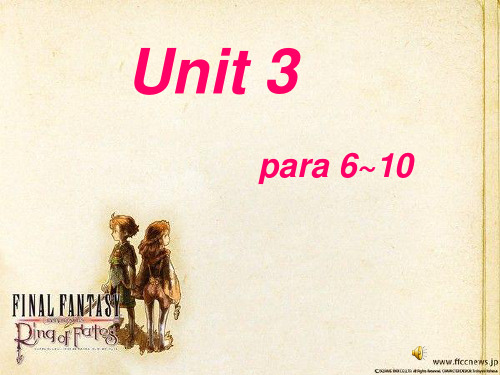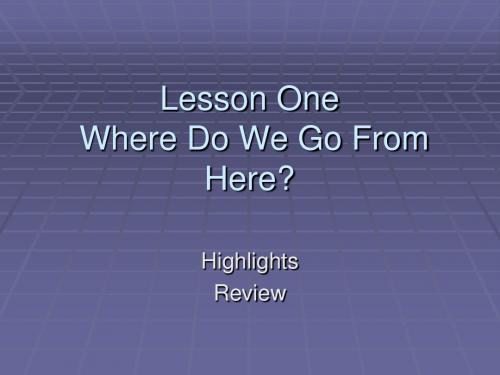大学英语课件
合集下载
大学英语综合教程 ppt课件ppt课件

01
Course Introduction
Chapter
Improve students' English listening, speaking, reading, and writing abilities
Developing students' cross-cultural communication skills
Through PPT courseware, deepen understanding of course content and improve learning effectiveness.
Collaborative learning
Learn together with classmates, share knowledge and experience, help each other, and progress together.
Textbook
Use the Comprehensive Course of College English to master basic knowledge and skills.
要点三
Comparison of Chinese and Western Thinking Styles: Comparative analysis of the differences in thinking styles, cognitive styles, and values between the East and the West, as well as the impact of these differences on cross-cultural communication.
Reasonably utilize learning resources, such as time, environment, and learning partners, to improve learning efficiency.
Course Introduction
Chapter
Improve students' English listening, speaking, reading, and writing abilities
Developing students' cross-cultural communication skills
Through PPT courseware, deepen understanding of course content and improve learning effectiveness.
Collaborative learning
Learn together with classmates, share knowledge and experience, help each other, and progress together.
Textbook
Use the Comprehensive Course of College English to master basic knowledge and skills.
要点三
Comparison of Chinese and Western Thinking Styles: Comparative analysis of the differences in thinking styles, cognitive styles, and values between the East and the West, as well as the impact of these differences on cross-cultural communication.
Reasonably utilize learning resources, such as time, environment, and learning partners, to improve learning efficiency.
大学英语ppt课件

• Compact:
1.small,but solid and strong 结实的 2.packed together closely and neatly 紧凑 That compact suitcase is easy to carry. 那个结实的箱子很容易提。 Tractors compact the soil. 拖拉机把土压紧
• What the main idea of para 6 to para 10?
• He was a bit on the short side, compactly built. (para 6)
他稍微矮了点,但长得很结实。
• on the…side
有点太… …
(一般用作表语或补语用)相当,
Unit 3
para 6~10
words
•Splash
:n.有色斑点
translation: • 我能听到下水道流水的声音。 • I can hear the splash of water in the sink. • Make a splash 发出溅泼声;做引人注目的 事 Splash down (飞船在海洋中)溅落
• bump into 偶然碰见 run bump into(against) 嘭的一下撞上 bumper [n]. 保险杆 bumpkin [n].乡下人;土包子 bumpy 凹凸不平的;疙疙瘩瘩的
• innocent
1.done or said without intending to harm or offend anyone 无恶意的 2.not guilty of a crime无罪的;无辜的 • 战争期间无辜的孩子们经常受到伤害。 • Innocent children are often harmed during a war 律师为那个妇女辩护,因为他相信她是无辜的 The lawyer defended the woman because he believed she was innoce作表语。 • on one’s behalf: (一般作状语)代表某人,
《大学英语》课件

further improve students' ability to speak English at a high level, including complex senses, advanced grammar, and suggestive expressions
Basic reading comprehension
要点一
要点二
Comparative Analysis
Enhance students to compare and contrast their own culture with those reported in the texts they are studying to enhance their cultural awareness
Advanced listening comprehension
further improve students' ability to understand English at a high level, including complex senses, advanced vocabulary, and suggestive expressions
Translation Techniques
Teach students translation techniques such as literal translation, free translation, and adaptation
Context Understanding
Help students understand the cultural and historical backgrounds of the source texts they are translating to enhance their translation accuracy
Basic reading comprehension
要点一
要点二
Comparative Analysis
Enhance students to compare and contrast their own culture with those reported in the texts they are studying to enhance their cultural awareness
Advanced listening comprehension
further improve students' ability to understand English at a high level, including complex senses, advanced vocabulary, and suggestive expressions
Translation Techniques
Teach students translation techniques such as literal translation, free translation, and adaptation
Context Understanding
Help students understand the cultural and historical backgrounds of the source texts they are translating to enhance their translation accuracy
大学英语PPT课件

2. potential -1
n. possibiliteloped 潜力;潜能
e.g. 这种产品在出口市场上拥有更大的销 售潜力。
The product has even more potential in export markets.
Part 2: Part 3: Part 4:
The meanings of “winner” and “loser” (Para. 2)
Few people are winners and losers all the time. (Para. 3)
Winners (Para. 4~7)
Part 5: Losers (Para. 8~10)
Unit 3 Born to Win
If you wish to succeed, you should use persistence as your good friend, experience as your reference, prudence as your brother and hope as your sentry.
Other similar phrases ?
look on…as … take… as… consider… as… see…as… view…as…
have…as… regard…as… consider…as… imagine … as… label…as…
2. When we refer to a person as a winner, we do not mean one who defeats the other person by dominating and making him lose.
Sentence pattern
大学英语三ppt课件ppt

It covers various business areas such as marketing, finance, human resources, and international trade, providing students with a solid foundation in business English communication
Social method
02
A teaching method that resources students to question and seek answers through critical thinking and analysis It founders a deep understanding of concepts
03
Cultural background and cross cultural communication
Values
Eastern culture emphases collectivism, while Western culture emphases individualism
Communication style
Module 3
Writing and Translation Skills
Module 4
English Culture and Literature
02
Language knowledge and skills
Basic elements
Vocabulary and grammar are the cornerstone of English learning. By learning new vocabulary and mastering grammar rules, students can better understand and apply English.
Social method
02
A teaching method that resources students to question and seek answers through critical thinking and analysis It founders a deep understanding of concepts
03
Cultural background and cross cultural communication
Values
Eastern culture emphases collectivism, while Western culture emphases individualism
Communication style
Module 3
Writing and Translation Skills
Module 4
English Culture and Literature
02
Language knowledge and skills
Basic elements
Vocabulary and grammar are the cornerstone of English learning. By learning new vocabulary and mastering grammar rules, students can better understand and apply English.
《现代大学英语》PPT课件

information such as is not furnished by 99% of the newspapers in the United States.
18
paralleled paradoxes: Without recognizing this we will end up
(2) Antithesis:
a) outer city of wealth and comfort vs. inner city of poverty and despair
b) dark yesterdays vs. bright tomorrows;
C) on the basis of the content of their
of signs and symbols that deals especially with their function in both artificially constructed and natural languages and comprises syntactics, semantics, and pragmatics
he can never advocate violence.
19 Antithesis
For through violence you may murder a
murderer but you can't murder murder.
Through violence you may murder a liar
life, the Negro has a double share.
There are twice as many unemployed. The rate of infant mortality among Negroes
18
paralleled paradoxes: Without recognizing this we will end up
(2) Antithesis:
a) outer city of wealth and comfort vs. inner city of poverty and despair
b) dark yesterdays vs. bright tomorrows;
C) on the basis of the content of their
of signs and symbols that deals especially with their function in both artificially constructed and natural languages and comprises syntactics, semantics, and pragmatics
he can never advocate violence.
19 Antithesis
For through violence you may murder a
murderer but you can't murder murder.
Through violence you may murder a liar
life, the Negro has a double share.
There are twice as many unemployed. The rate of infant mortality among Negroes
大学英语综合教程4unitPPT课件

• Inverted sentence: Inverted sentence refers to placing certain components (such as predicate, subject, etc.) at the beginning of a sentence to emphasize or change the sentence structure. For example, "Only in this way can we solve the problem."
01
Unit Introduction
Unit Theme
Summary
Unit Theme Introduction
Detailed description
The theme of this unit is "Global Climate Change", which mainly explores the current situation, causes and impacts of global climate change, as well as individual and social response strategies.
Teaching objectives
Summary
Explanation of teaching objectives
Detailed description
The teaching objectives of this unit include: cultivating students' reading comprehension ability, enabling them to master vocabulary and expressions related to global climate change, understanding the scientific principles of global climate change, and improving their critical thinking ability and environmental awareness.
01
Unit Introduction
Unit Theme
Summary
Unit Theme Introduction
Detailed description
The theme of this unit is "Global Climate Change", which mainly explores the current situation, causes and impacts of global climate change, as well as individual and social response strategies.
Teaching objectives
Summary
Explanation of teaching objectives
Detailed description
The teaching objectives of this unit include: cultivating students' reading comprehension ability, enabling them to master vocabulary and expressions related to global climate change, understanding the scientific principles of global climate change, and improving their critical thinking ability and environmental awareness.
大学英语ppt优秀课件

The Learning Objectives of College English
• Fluent English speaking: Students learning English at college should aim to achieve fluency in speaking, including promotion, grammar, and vocabulary They should be able to express their ideas clearly and fluently in English and engage in effective communication
Excellent PowerPoint courseware for college English
contents
目录
• Introduction to College English • College English Vocabulary Lea • College English Listening Trail • College English Oral Expressio
02
Make a note
Read books, newspapers, and other materials in English to enroll new words and phrases and understand their usage
When you enroll a new word or phrase, write it down in a notebook or use an app to create a digital flashcard for easy review
- 1、下载文档前请自行甄别文档内容的完整性,平台不提供额外的编辑、内容补充、找答案等附加服务。
- 2、"仅部分预览"的文档,不可在线预览部分如存在完整性等问题,可反馈申请退款(可完整预览的文档不适用该条件!)。
- 3、如文档侵犯您的权益,请联系客服反馈,我们会尽快为您处理(人工客服工作时间:9:00-18:30)。
11-9
Page 321
Information Flow (Page 2 of 2)
11-10
Page 321
Computer-Based Information Systems
11-11
Page 323
Transaction Processing Systems (TPS)
• Tracks operations • Creates and records events in databases • Also called data processing TPS database systems (DPS) • One of the most essential uses of a TPS are accounting activities
• Accounting – records all financial activity from billing customers to paying employees • Marketing – plans, prices, promotes, sells, and distributes the organization’s goods and services • Human resources – focuses on people—hiring, training, promoting, and other human-centered activities • Production – actually creates finished goods and services using raw materials and personnel • Research – identifies, investigates, and develops new products and services
11-7
Management Levels
• Management in many organizations is divided into three levels: Top, Middle, and Supervisors
Return
Page 320
11-8
Information Flow (Page 1 of 2)
problems
– Produces reports that do not have a fixed format
• Must be easy to use • Has four parts
Query results for SALES < QUOTA
11-15
Page 326
4 Parts of a DSS
– Periodic reports
produced at regular intervals
– Exception reports
call attention to unusual events
– Demand reports
Management information system report
– Use specialized systems – CAD/CAM
11-20
Page 329
Information workers
• Typically information workers create, distribute, and communicate information. • Information workers –
11-5
Page 318
Five Functions of an Organization
• Accounting
• Marketing
• Human Resources
• Production • Research
Page 319
Return
11-6
Five Functions of an Organization
Other Information Systems
• Office automation systems (OASs) support the activities of data workers by managing documents, communications, and scheduling. Secretaries and clerks are data workers • Project Managers – programs designed to schedule, plan, and control project resources • Videoconferencing systems – computer systems using the computer and Internet that allow people located at various geographical locations to communicate and conduct in-person meetings (group video chat) • Knowledge work systems (KWSs) • CAD/CAM (computer-aided design/computer-aided manufacturing) – used by design and manufacturing engineers
opposite of periodic, is produced only upon request
11-14
Page 325
Decision Support Systems (DSS)
• Flexible tool for analyzing data
• Enables managers to get answers to
11-17
Page 327
Executive Support Systems (ESS)
• Designed for top management and easy use
• Consists of
sophisticated software • Provides immediate access to a company's performance
Competencies (Page 1 of 2)
• Explain how organizations can be structured according to five functions and three management levels • Describe how information flows in an organization • Distinguish among a transaction processing system, a management information system, a decision support system, and an executive support system
• Office automation systems (OASs)
– Project managers – Videoconferencing systems
– Knowledge workers
• Engineers • Scientist
• Knowledge work systems (KWSs)
11-12
Page 323
Accounting Activities TPS
• Sales order processing • Accounts receivable • Inventory and purchasing
Page 324
• Accounts payable • Payroll • General ledger
• Communication and distribution - data workers; include but not limited to secretaries, clerks, • Creation - knowledge workers; engineers, and scientists
11-18
Page 327
can present, summarize, and analyze data from an organization’s databases
Other Information Systems
• Information workers
– Data workers
• Secretaries • Clerks
11-1
Page 314
Competencies (Page 2 of 2)
• Distinguish between office automation systems and knowledge work systems • Explain the difference between data workers and knowledge workers
– They all work together to provide information essential to running an organization
11-4
Page 317
Organizational Information Flow
• Information flows vertically and horizontally throughout an organization • Information Systems support the natural flow of information within an organization’s structure • 5 Functions • Management Levels • Information Flow
